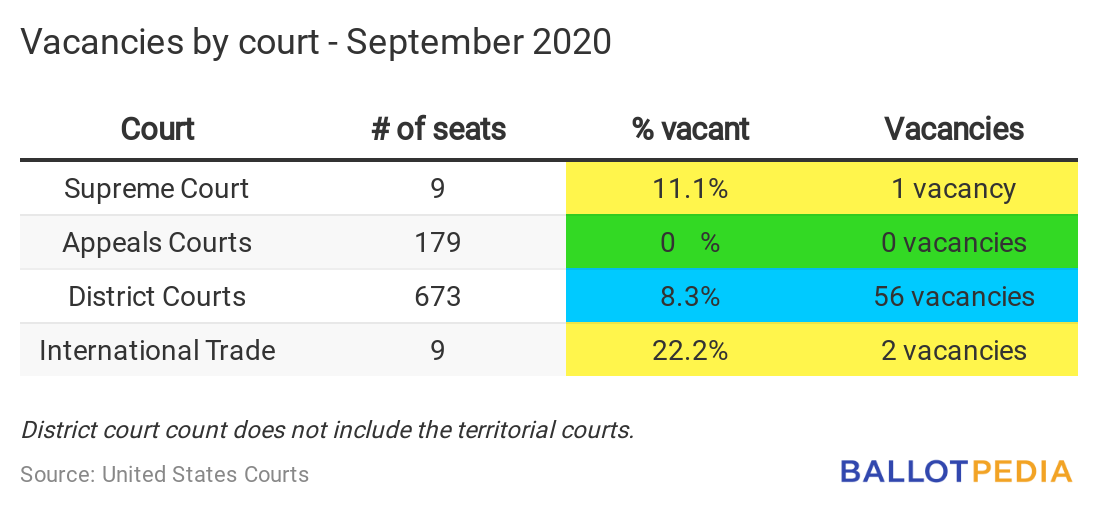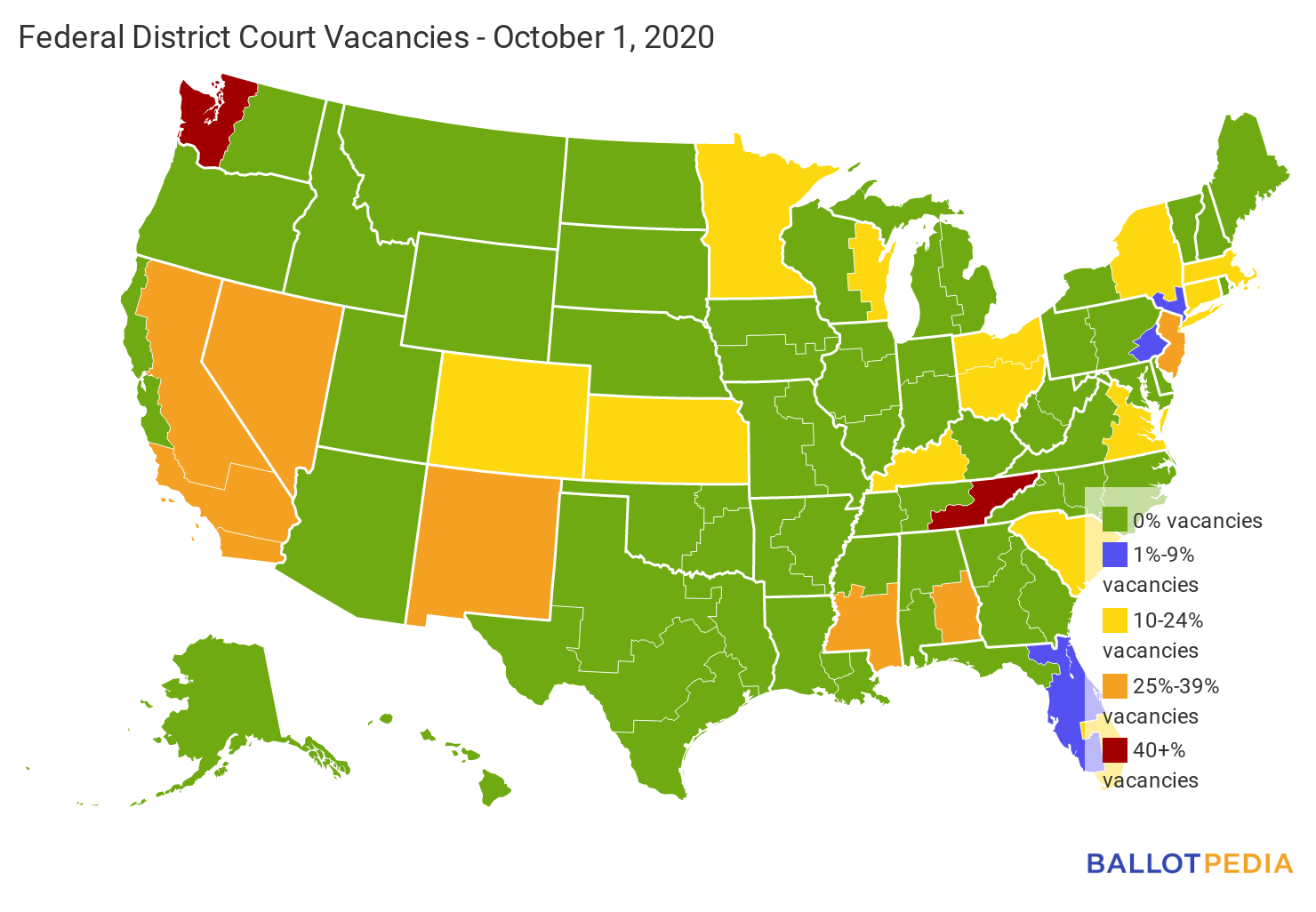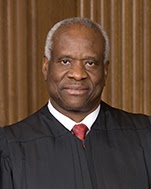| Welcome to the October 5 edition of Bold Justice, Ballotpedia’s newsletter about the Supreme Court of the United States (SCOTUS) and other judicial happenings around the U.S. SCOTUS begins its new term today! Keep up with the latest court news by following us on Twitter or subscribing to the Daily Brew. |

Arguments
The Supreme Court will hear six hours of arguments this week. Click here to read more about SCOTUS’ current term.
In its October 2019 term, SCOTUS heard arguments in 61 cases. Click here to read more about SCOTUS’ previous term.
Click the links below to read more about the specific cases SCOTUS will hear this week:
- October 5
- In Carney v. Adams, James Adams, a retired Delaware lawyer, sued Delaware Gov. John Carney (D) over Article IV, Section 3 of the Delaware Constitution. Article IV, Section 3 says that no more than the bare majority of judges on a given Delaware court can be of the same political party.
Adams argued the provision violated the First Amendment. Carney argued Adams did not have the legal right, or standing, to file a lawsuit. A federal magistrate judge ruled the provision was unconstitutional.
On appeal, the U.S. Court of Appeals for the 3rd Circuit affirmed in part and reversed in part the U.S. district court’s ruling. Carney appealed to the U.S. Supreme Court, arguing the 3rd Circuit’s decision conflicted with decisions in similar cases from the 2nd Circuit, 6th Circuit, and the 7th Circuit.
The issue: Does Article IV, Section 3 of the Delaware Constitution violate the First Amendment?
- Texas v. New Mexico concerns an interstate water dispute between Texas and New Mexico. It is part of the court’s original jurisdiction, meaning SCOTUS is the first and only court to hear the case.
Texas and New Mexico entered a compact about use of the Pecos River. The U.S. Supreme Court appointed a river master to issue an annual report summarizing New Mexico’s compliance with its compact obligations. In 2014, the Pecos River flooded. New Mexico released the flood water downstream, even though Texas’ reservoir could not hold the extra water.
Texas alleges the water was wasted. In mid-2018, New Mexico asked the river master to reduce its delivery obligations because of the 2014-2015 flood water. The river master retroactively changed the 2015 report, against Texas’ objections.
Texas challenged the river master’s retroactive modifications and his 2018 annual report. While that challenge was pending, the river master filed a 2019 annual report, which Texas also petitioned the U.S. Supreme Court to review.
The issue: Whether the river master was wrong to retroactively change the 2015 annual report and to charge Texas for evaporative losses without authority under the Compact.
- October 6
- In Rutledge v. Pharmaceutical Care Management Association, the Pharmaceutical Care Management Association filed a lawsuit challenging a 2015 Arkansas law. The law included mandates for pharmacy reimbursement for drug costs, new requirements for pharmacy benefits managers’ updates to maximum allowable cost lists, and administrative appeal procedures.
Pharmaceutical Care Management Association sued on behalf of its pharmacy benefits manager members, claiming the Employee Retirement Income Security Act of 1974 (ERISA) and Medicare Part D preempted the state law. The association also argued the law was unconstitutional.
The U.S. District Court for the Eastern District of Arkansas ruled that ERISA preempted the law, but Medicare Part D did not. The district court also ruled the law was constitutional. On appeal, the 8th Circuit affirmed in part and reversed in part the district court’s decision, and remanded the case for entry of judgment in favor of the Pharmaceutical Care Management Association.
The issue: Whether the 8th Circuit incorrectly held that the ERISA preempted a 2015 Arkansas law, which is similar to laws in a majority of states, violating the Supreme Court’s precedent that ERISA does not preempt rate regulation.
- In FNU Tanzin v. Tanvir, Muhammad Tanvir, Jameel Algibah, and Naveed Shinwari, were born outside of the United States and later moved to the U.S., where they became U.S. citizens or lawful permanent residents. The three men, who practice Islam, sued FBI agents in their official and individual capacities in the U.S. District Court for the Southern District of New York. Tanvir, Algibah, and Shinwari claimed the FBI agents retaliated against them after the three men, citing their religious beliefs, declined to act as informants. Plaintiffs alleged the agents violated the Administrative Procedure Act, the Religious Freedom Restoration Act (RFRA), as well as their First and Fifth Amendment rights.
The U.S. District Court dismissed the claims against the agents in their individual capacity. The three men appealed to the 2nd Circuit Court of Appeals, which reversed the lower court’s ruling. FBI Special Agent FNU (First Name Unknown) Tanzin appealed to the U.S. Supreme Court after the 2nd Circuit denied his motion for a rehearing en banc.
The issue: Whether the RFRA provision 42 U.S.C. 2000bb-1(c) authorizes monetary damages against federal employees sued in their individual capacities.
42 U.S.C. 2000bb-1(c) says a person whose religious exercise has been violated “may assert that violation as a claim or defense in a judicial proceeding and obtain appropriate relief against a government.”
- October 7
- In Google LLC v. Oracle America Inc., Oracle sued Google for copyright and patent infringement after Google used portions of Oracle-owned Java programming software for Android mobile devices. The case was brought to the U.S. District Court for the Northern District of California twice and appealed to the U.S. Court of Appeals for the Federal Circuit twice.
In the first trial and appeal, a jury found that Google infringed on Oracle’s copyrights, but was deadlocked on whether Google’s copying was a fair use. After the verdict, the district court dismissed Oracle’s claim, holding the programming was not copyrightable as a matter of law. The appeals court reversed the district court’s ruling.
In the second trial and appeal, the district court ruled in favor of Google. The appeals court reversed the district court’s ruling and remanded the case.
The issues:
(1) Does copyright protection extend to a software interface?
(2) Does Google’s use of a software interface to create a new computer program constitute fair use?
- Ford Motor Company v. Montana Eighth Judicial District Court was consolidated with Ford Motor Company v. Bandemer.
In Ford Motor Company v. Montana Eighth Judicial District Court, Montana resident Markkaya Jean Gullett died after one of the tires of her 1996 Ford Explorer experienced a tread/belt separation. The vehicle lost stability and rolled into a ditch. A personal representative sued Ford for liability and negligence.
In Ford Motor Company v. Bandemer, Minnesota resident Adam Bandemer sustained a severe brain injury as a passenger in a 1994 Ford Crown Victoria. The driver of the vehicle rear-ended a county snowplow and the car ended up in a ditch. Bandemer alleged that the passenger-side airbag did not deploy during the accident and sued Ford for product liability, negligence, and breach of warranty claims.
In both cases, Ford Motor Company moved to dismiss the claims in state district court, citing a lack of personal jurisdiction. Ford’s motions were denied. On appeal in both cases, the state courts of appeal affirmed the lower court rulings. Ford appealed the cases to the respective state supreme courts, which affirmed the rulings of the courts of appeal.
The issue (from SCOTUSblog): “Whether the ‘arise out of or relate to’ requirement of the 14th Amendment’s due process clause is met when none of the defendant’s forum contacts caused the plaintiff’s claims, such that the plaintiff’s claims would be the same even if the defendant had no forum contacts.”
Death of Justice Ruth Bader Ginsburg
 Associate Justice Ruth Bader Ginsburg died on September 18, 2020. Ginsburg joined the court on August 5, 1993. President Bill Clinton (D) nominated her to the court, and the U.S. Senate confirmed the nomination by a 96-3 vote on August 3, 1993. Associate Justice Ruth Bader Ginsburg died on September 18, 2020. Ginsburg joined the court on August 5, 1993. President Bill Clinton (D) nominated her to the court, and the U.S. Senate confirmed the nomination by a 96-3 vote on August 3, 1993.
Before joining the U.S. Supreme Court, Ginsburg was a judge on the U.S. Court of Appeals for the D.C. Circuit. Before that, she worked in a variety of roles, including as a fellow for the Center for Advanced Study in the Behavioral Sciences, in Stanford, California; general counsel for the American Civil Liberties Union; a consultant for the U.S. Commission on Civil Rights, and a professor at the Rutgers School of Law.
Ginsburg was born in Brooklyn, New York, on March 15, 1933. She earned her bachelor’s degree from Cornell University in 1954. Ginsburg then enrolled at Harvard Law School, later transferring to Columbia Law School. She earned her LL.B. degree from Columbia in 1959.
On September 29, 2020, President Trump nominated Amy Coney Barrett to succeed Ginsburg. Barrett is a judge on the U.S. Court of Appeals for the 7th Circuit.
Upcoming SCOTUS dates
Here are the upcoming dates of interest in October:
- October 5: SCOTUS began its 2020-2021 term, hearing arguments in two cases.
- October 6: SCOTUS will hear arguments in two cases.
- October 7: SCOTUS will hear arguments in two cases.
- October 9: SCOTUS will conference. A conference is a private meeting of the justices.
|
 Since 1962, what is the average amount of time a Supreme Court seat has been vacant (defined as the length of time between a justice’s departure date and the swearing-in of their successor)? Since 1962, what is the average amount of time a Supreme Court seat has been vacant (defined as the length of time between a justice’s departure date and the swearing-in of their successor)?
- 422 days
- 391 days
- 88 days
- 77 days
Choose an answer to find out! |

The Federal Vacancy Count tracks vacancies, nominations, and confirmations to all United States Article III federal courts in a one-month period. This month’s edition includes nominations, confirmations, and vacancies from September 2 to October 1.
Highlights
- Vacancies: There have been two new judicial vacancies since the previous report. There are 59 vacancies out of 870 active Article III judicial positions on courts covered in this report. Including the U.S. Court of Federal Claims and the United States territorial courts, 64 of 890 active federal judicial positions are vacant.
- Nominations: There have been four new nominations since the previous report.
- Confirmations: There have been 15 new confirmations since the previous report.
Vacancy count for October 1, 2020
A breakdown of the vacancies at each level can be found in the table below. For a more detailed look at the vacancies on the federal courts, click here.

*Though the United States territorial courts are named as district courts, they are not Article III courts. They are created in accordance with the power granted under Article IV of the U.S. Constitution. Click here for more information.
New vacancies
Two judges left active status, creating Article III life-term judicial vacancies, since the previous vacancy count. As Article III judicial positions, a presidential nomination is required to fill vacancies. Nominations are subject to confirmation on the advice and consent of the U.S. Senate.
U.S. District Court vacancies
The following map displays U.S. District Court vacancies as of October 1.

New nominations
President Trump has announced four new nominations since the previous report.
- Amy Coney Barrett, to the U.S. Supreme Court.
- Charles Atchley, to the United States District Court for the Eastern District of Tennessee.
- Katherine Crytzer, to the United States District Court for the Eastern District of Tennessee.
- Joseph Dawson, to the United States District Court for the District of South Carolina.
The president has announced 271 Article III judicial nominations since taking office January 20, 2017. The president named 69 judicial nominees in 2017, 92 in 2018, and 77 in 2019. For more information on the president’s judicial nominees, click here.
New confirmations
Between September 2 and October 1, the Senate confirmed 15 of the president’s nominees to Article III courts.
- Roderick Young, confirmed to the U.S. District Court for the Eastern District of Virginia.
- John Hinderaker, confirmed to the U.S. District Court for the District of Arizona.
- Iain Johnston, confirmed to the U.S. District Court for the Northern District of Illinois.
- Franklin Valderrama, confirmed to the U.S. District Court for the Northern District of Illinois.
- David Dugan, confirmed to the U.S. District Court for the Southern District of Illinois.
- Stephen P. McGlynn, confirmed to the U.S. District Court for the Southern District of Illinois.
- Todd Robinson, confirmed to the U.S. District Court for the Southern District of California.
- Stanley Blumenfeld, confirmed to the U.S. District Court for the Central District of California.
- John Holcomb, confirmed to the U.S. District Court for the Central District of California.
- Mark Scarsi, confirmed to the U.S. District Court for the Central District of California.
- Diane Gujarati, confirmed to the U.S. District Court for the Eastern District of New York.
- Thomas Cullen, confirmed to the U.S. District Court for the Western District of Virginia.
- Hala Jarbou, confirmed to the U.S. District Court for the Western District of Michigan.
- Christy Wiegand, confirmed to the U.S. District Court for the Western District of Pennsylvania.
- Brett Ludwig, confirmed to the U.S. District Court for the Eastern District of Wisconsin.
Between January 2017 and October 1, 2020, the Senate confirmed 218 of President Trump’s judicial nominees—161 district court judges, 53 appeals court judges, two Court of International Trade judges, and two Supreme Court justices.
Need a daily fix of judicial nomination, confirmation, and vacancy information? Click here for continuing updates on the status of all federal judicial nominees.
Or, if you prefer, we also maintain a list of individuals the president has nominated. |
 
In the next several Bold Justice editions, we’re taking a closer look at the U.S. Supreme Court justices. Today, we’re learning about Associate Justice Clarence Thomas.
Thomas has been an associate justice since October 18, 1991. President George H.W. Bush (R) nominated Thomas on July 1, 1991, to succeed Thurgood Marshall. The U.S. Senate confirmed Thomas by a 52-48 vote on October 15, 1991.
Before joining the U.S. Supreme Court, Thomas was a judge on the U.S. Court of Appeals for the D.C. Circuit. Before that, he was the chairman of the U.S. Equal Employment Opportunity Commission, an assistant secretary of education in the U.S. Department of Education’s Office of Civil Rights, and a legislative assistant for Sen. John Danforth (R-Mo.).
Thomas was born in Savannah, Georgia, in 1948. Raised Roman Catholic, Thomas considered entering the priesthood at the age of 16 and attended St. John Vianney’s Minor Seminary. He then continued his studies at Conception Abbey Seminary in Missouri, but left to attend the College of the Holy Cross in Worcester, Massachusetts. He graduated in 1971 with a B.A., cum laude, in English literature. Thomas earned his J.D. from Yale Law School in 1974.
In the 2019-2020 term, Thomas wrote the following opinions:
|

We’ll be back October 12 with a new edition of Bold Justice. |
|